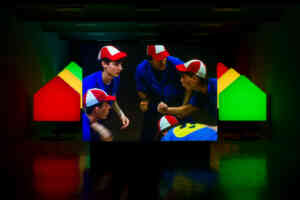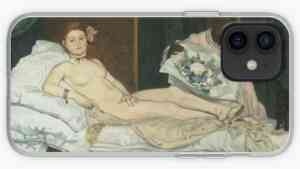Fair game

Gamification is ubiquitous. From social media apps and fitness feeds to the motivation-enhancing transformation of activity areas into game play, more and more aspects of our everyday lives are being driven by game elements.
How is our environment, our perception changing with "gamification"? And how do artistic strategies and formats change through video games? A lot has happened since the U.S. artist Cory Arcangel (b. 1978 in Buffalo, USA) presented his now iconic work Super Mario Clouds at the Whitney Biennial in 2004, or the Chinese artist Cao Fei (b. 1978 in Guangzhou, China) created her own world in 2007 with RMB City1: A Second Life City Planning as avatar China Tracy, based on the structural principles and participation possibilities of the then very popular platform Second Life.
The art world is currently flooded with a variety of digital, interactive website formats. Increasingly, these draw not only on aesthetics, but on the systematics and reward strategies of video games that tap into our intrinsic and extrinsic motivations for growth and self-optimization. The goal is usually to generate a change in behaviour and an increase in motivation in the (art) viewer, who increasingly becomes a "user". Gamification is thus used as a goal-oriented means to challenge the user in an interactive way so that his/her reward system comes into play. Museums, biennials or art festivals, which are nowadays looking for new digital sources of income in order to remain attractive to a younger audience, also combine the classic educational mission with game elements in order to strengthen the motivation to engage with art.
The principle of gamification is initially reminiscent of some types of interactive or immersive art that we have seen in recent decades. Here, too, the viewer's distance from the work of art is to be overcome, the viewers are to abandon themselves to the work of art, so to speak, or to immerse themselves in the work. By eliminating in this way the potentially free, distanced mode of viewing traditionally claimed above all in the field of fine art, the viewers are no longer free in the classical sense in their relationship to the work. They cannot take as much time as they like for what is ideally contemplative viewing, but are "taken along" by the work. They enter the carousel instead of viewing it from all sides. This raises the fundamental question of meaning. Is there a meaning beyond the mere taking part? In this case, does gamified art have, what it takes to be a commentary or an imaginary sign of a physical reality? For this, there would have to exist a certain spatial or temporal distance between significate and significant. However, since the strictly gamified artwork has a specific goal, it does not enable a reaction about the work, but rather animates the viewers/users to pursue a goal. Thus, the reaction occurs in the work. In this way, art approaches not only games, but also economic procedures, since it is primarily large companies that use such strategies for themselves in times of pervasive economization. Amazon, for example, has provided warehouse work with game tasks in order to achieve better employee motivation. Gamified work thus aims directly at the reward system and in this way runs the risk of opening the way to permanent manipulation. After all, those who play are reassured, since a game always conveys control and security.
Many of the more recent works in the field of gamified art nevertheless see themselves as a kind of commentary on reality, on a reality, however, that immediately swallows up any commentary. For it is becoming increasingly difficult to distinguish what is reality and what is commentary. The categories are mixing. In addition to physical reality, a digital reality has emerged that has again splintered into many other realities with corresponding truth claims and whose reality effects are in part stronger than the effects of the physical. Added to this is AI as an ever-evolving intelligence. In this respect, the more advanced forms of gamified art do encounter reality critically, combining affirmation (mostly of the technical) and a critical gaze (with regard to the urgency of recognizing, acting, changing) with a sense of reality shrinking further and further into the infinite hole of the present. The following are some examples that have captured my interest in this regard.
Recently I came across an interesting concept on the site of KW-Institute for contemporary art, Berlin. Open Secret. The explanation states:
When one opens the project page, a black screen appears. Only when you move the cursor over the surface does the text become visible, as if you had "wiped clean" a pane above it. Then you can explore the actual page via the "Enter" key. Immediately one feels reminded of adventure games. This kind of website programming takes games, virtual reality and augmented reality, motion capture apps, interactive websites, platforms, Citizen Science projects or AI to use as concepts of mediation that enable and encourage interaction and a new kind of participation in a literally "playful" way. As a result of the pandemic, these concepts have exploded with compelling features that not only make it easier for readers to anticipate the content, but downright fun.
"But what makes (...) it so different? So appealing?2" A notable example of the connection from the fictional is the artist collective Omsk Social Club or FKA PUNK IS DADA. The members of the collective remain in the background. They describe their work on the website:
In June 2020, OMSK presented their longest continuous live-action role-play to date at Kunstraum Bethanien in Berlin-Kreuzberg, lasting 56 days. Across three platforms and two physical spaces, the idea of online existence was presented as a "Cosmic depression-Paradise without ecology“3. For the online program of Light Art Space, Berlin (LAS), Omsk created a platform that could be activated via a screensaver over the duration of the online presence. Behind lies a narration with no end: The Wet Altar. The title is based on the term 'wetware', which connects the central nervous system to the human mind. In the Tibetan Book of the Dead, 'wetware' describes the unconscious. In the 20th century, the term also finds prominence in the genre of science fiction from the 1950s onward. The Real Game Play approach characteristic of OMSK is also used here, moving between fiction and reality. The narration develops in the style of choose-your-own-adventure stories at the intersection of sci-fi, technology, magic, and current political events. Through active participation and conscious perception, the participants are directly involved in the creation of the imaginary worlds. OMSK Social Club uses participatory practices for which the collective is known. Acoustic elements and embedded commands intensify the effect. Inspired by artist Leonora Carrington, philosopher Simone Weils, and author Nnedi Okorafors, The Wet Altar questions how narratives can affect our subconscious.
"What if AI could do the job of living your life better than you?"4 Gamification and artificial intelligence are hard to separate. The question of how the internet, algorithms and AI control and direct the patterns of our future lives is omnipresent. In his groundbreaking work Life after BOB, American artist Ian Cheng (b. 1984 in Los Angeles, USA) explored the psychological consequences of the human brain becoming increasingly interconnected with artificial companions, without which it cannot cope with the demands of an ever-changing environment. To anticipate future demands and the resilience required, the principles of videogames are used to develop a series of simulations through which the agent must pass. Working with his production team, Cheng developed this 48-minute animation with UNITY using traditional animation storytelling techniques and various real-time cinematic tools. These techniques allow Life After BOB to incorporate real-time changes that are unique to each viewing.
At The Shed in New York or more recently in Zurich at LUMA Westbau, the work has been presented on a large-scale screen that, in conjunction with an interactive "world watching" technique, allows viewers to freely explore the details of Life After BOB's world at their own pace. Viewers are invited to check out the Life After BOB wiki, learn about the protagonists, the flora and fauna, and all the background details. And here again, interaction comes into play. Viewers are invited to contribute to and edit this wiki. These edits, in turn, continuously modify the details of the world on the screen, expanding Life After BOB into a new form of programmable narrative media.
One artist who addressed this issue before social media or virtual interaction is U.S. video pioneer Ericka Beckman (b. 1951 in New York, USA). "Fair Game" is the name of the exhibition, which was on view at the Kestner Gesellschaft in Hanover until January 9, 2022.5 The title is unmistakably an allusion to the artist's exploration of the aspect of gamification. Since the 1980s, her video installations have explored how "the use of play as a structuring device of capitalist society" is negotiated. Borrowing from the visual and musical aesthetics of a low-budget children's program of the 1980s, Beckman produced her first 16mm film, You the Better, in 1983. Most of the film features a group of uniformed players in a black room, playing by a few clear rules. Their opponent is depersonalized capital, which continually outwits the players. In the end, the question arises: can a dominant system ever be outwitted? Let’s play!
- Notes:
- 1 Named after the Chinese unit of currency, renminbi (often abbreviated as RMB), RMB City is a surrealist cityscape that draws on a combination of modern, ancient, and contemporary Chinese urbanism and visual elements.
- 2 A quote taken from the title of ´Just what is it that makes today's homes so different, so appealing?´ is a collage by English artist Richard Hamilton. It measures 10.25 in (260 mm) × 9.75 in (248 mm). The work is now in the collection of the Kunsthalle Tübingen, Tübingen, Germany. It was the first work of pop art to achieve iconic status.
- 3 see also: https://www.kunstraumkreuzberg.de
- 4 https://lifeafterbob.io/
- 5 https://kestnergesellschaft.de/de/ausstellung/8
- Credit for image:
- Ericka Beckman, You the Better, Film installation 1983/2015, Photo: Iris Ranzinger


